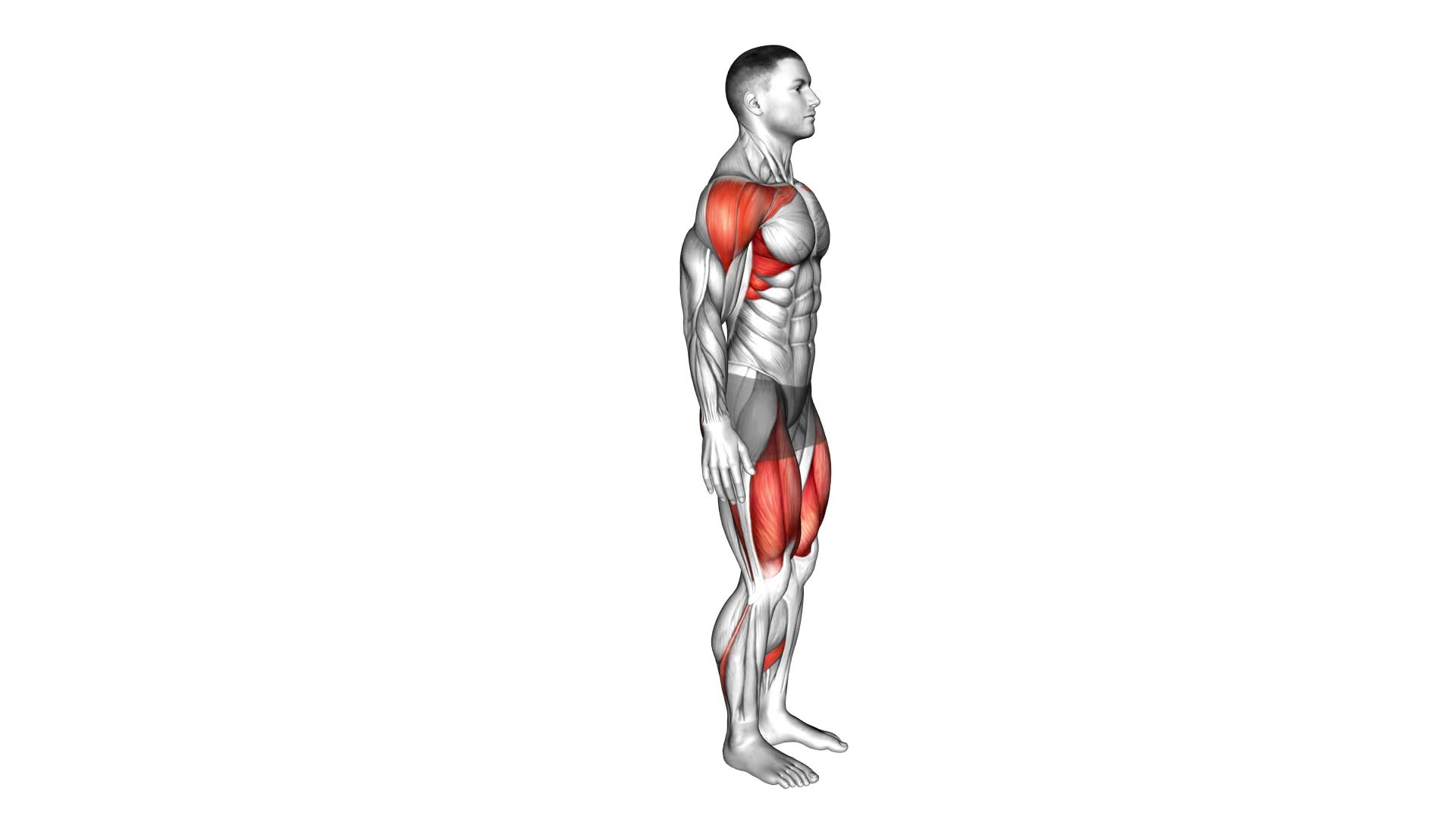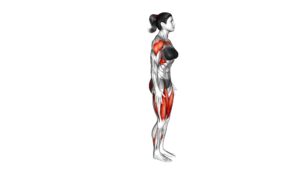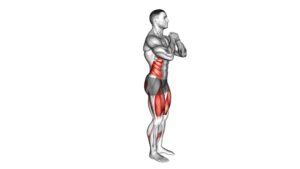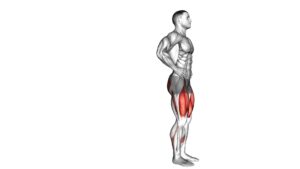Bodyweight Rear Lunge Front Raise (male) – Video Exercise Guide & Tips

Are you looking for an effective exercise to target your legs and shoulders? Look no further than the bodyweight rear lunge front raise.
Watch This Exercise Video
This exercise combines the powerful movement of a lunge with the added challenge of raising your arms overhead. Not only will it increase your leg strength and stability, but it will also sculpt and define your shoulders.
In this article, we'll guide you through proper form, variations, and common mistakes to help you maximize your results.
Let's get started!
Key Takeaways
- Targets multiple muscle groups simultaneously: quadriceps, hamstrings, glutes, and calves
- Improves leg strength and stability
- Tones and sculpts the shoulders
- Enhances overall balance and stability
Benefits of the Bodyweight Rear Lunge Front Raise
To experience the benefits of the Bodyweight Rear Lunge Front Raise, you should incorporate this exercise into your workout routine. Incorporating lunges into your workout routine has numerous benefits. Firstly, lunges are a compound exercise that target multiple muscle groups simultaneously, including the quadriceps, hamstrings, glutes, and calves. This means that by performing the Bodyweight Rear Lunge Front Raise, you're effectively strengthening and toning these muscles. Additionally, lunges also help improve your balance and stability, as they require you to engage your core muscles to maintain proper form throughout the movement.
For beginners, it's important to modify the Bodyweight Rear Lunge Front Raise to ensure proper execution and prevent injury. To do this, you can start by performing the exercise without any weights, focusing on mastering the movement and maintaining proper form. As you become more comfortable, you can gradually add weights, such as dumbbells, to increase the intensity of the exercise.
Incorporating the Bodyweight Rear Lunge Front Raise into your workout routine not only helps strengthen and tone your lower body muscles, but it also improves your overall balance and stability. By modifying the exercise for beginners, you can safely and effectively reap these benefits while gradually progressing towards more challenging variations.
Proper Form and Technique
Mastering the proper form and technique of the Bodyweight Rear Lunge Front Raise is crucial for maximizing the effectiveness and safety of this exercise. To ensure you're performing the Bodyweight Rear Lunge Front Raise correctly, follow these key points:
- Stand with your feet hip-width apart and maintain good posture throughout the exercise.
- Take a step back with one leg and lower your body into a lunge position, ensuring your front knee is directly above your ankle.
- As you lower into the lunge, simultaneously raise your arms in front of you until they're parallel to the ground.
- Engage your core muscles and maintain a steady balance throughout the exercise.
- Slowly return to the starting position by pushing through your front heel and lowering your arms.
By focusing on proper form and technique, you can target specific muscle groups such as the quadriceps, glutes, hamstrings, and shoulders. Additionally, the Bodyweight Rear Lunge Front Raise helps improve balance as it requires stability and control throughout the movement.
Remember to start with light weights or no weights at all and gradually increase the intensity as you become more comfortable with the exercise.
Variations and Progressions
Try incorporating different variations and progressions of the Bodyweight Rear Lunge Front Raise to challenge your muscles and continue making progress. To add more intensity to this exercise, you can use advanced modifications or different equipment options.
One advanced modification you can try is adding weights to the exercise. Holding dumbbells or a barbell in your hands while performing the Bodyweight Rear Lunge Front Raise will increase the resistance and make the exercise more challenging. This will help to further strengthen your leg muscles and improve your balance and stability.
Another variation you can try is the Reverse Lunge Front Raise. Instead of stepping back into a rear lunge, you'll step forward into a reverse lunge. This variation targets your muscles in a slightly different way and can help to further engage your glutes and quadriceps.
If you have access to a resistance band, you can also incorporate it into your Bodyweight Rear Lunge Front Raise. By wrapping the band around your thighs or ankles, you can create additional resistance and make the exercise more challenging.
Remember to always listen to your body and choose variations that are appropriate for your fitness level. Gradually increase the difficulty as you become stronger and more comfortable with the exercise.
Common Mistakes to Avoid
One common mistake to avoid when performing the Bodyweight Rear Lunge Front Raise is allowing your knees to extend beyond your toes, as this can put unnecessary strain on your joints. To ensure proper form and maximize the benefits of this exercise, here are some tips for improvement:
- Maintain proper alignment: Keep your knees in line with your toes throughout the movement. This helps distribute the load evenly and reduces the risk of injury.
- Engage your core: Activate your core muscles to stabilize your body during the lunge and front raise. This helps maintain balance and control.
- Control the movement: Avoid rushing through the exercise. Focus on maintaining control and stability as you step back into the lunge and raise your arms.
- Use proper weight: Start with a weight that challenges you but allows you to maintain proper form. Gradually increase the weight as you become more comfortable and confident with the exercise.
- Warm up and stretch: Prior to performing the Bodyweight Rear Lunge Front Raise, warm up your muscles with some light cardio and dynamic stretches. This helps prepare your body for the exercise and reduces the risk of injury.
Tips for Maximizing Results
To maximize your results with the Bodyweight Rear Lunge Front Raise, focus on incorporating these key tips into your workout routine.
First, it's essential to maximize the intensity of your exercises. This can be achieved by performing the lunges and front raises with proper form and control. Ensure that you're engaging the targeted muscles throughout the entire movement and avoid rushing through the exercises. By slowing down and focusing on the contraction of your muscles, you'll increase the intensity and effectiveness of each repetition.
In addition to maximizing intensity, incorporating weights into your Bodyweight Rear Lunge Front Raise can further enhance your results. Start by using light dumbbells or resistance bands and gradually increase the weight as you progress. Adding weights will challenge your muscles and promote muscle growth and strength development. It's important to choose a weight that allows you to perform the exercise with proper form and without straining or compromising your technique.
Remember to always listen to your body and adjust the weight accordingly. Form and control should never be sacrificed for heavier weights. By incorporating weights into your routine, you won't only increase muscular strength but also burn more calories and boost your metabolism.
Frequently Asked Questions
How Many Calories Does the Bodyweight Rear Lunge Front Raise Burn?
When it comes to burning calories, the bodyweight rear lunge front raise is a great exercise choice. This challenging move targets multiple muscle groups, helping you burn more calories in the process.
By incorporating a front raise into a rear lunge, you engage your leg, glute, and shoulder muscles simultaneously. The more intense you make the exercise, the more calories you'll burn.
Remember to modify the exercise based on your fitness level to maximize calorie burn while ensuring safety.
Can I Do the Exercise Without Weights?
Yes, you can definitely do the bodyweight rear lunge front raise exercise without weights.
It's a great modification for beginners who want to focus on building strength and stability before adding weights.
By performing the exercise without weights, you can still engage your leg and shoulder muscles effectively.
Remember to maintain proper form and control throughout the movement to maximize the benefits of this exercise.
How Many Sets and Reps Should I Do for This Exercise?
To determine how many sets and reps you should do for this exercise, consider your fitness level and goals. A good starting point is 2-3 sets of 10-12 reps. Rest for about 30-60 seconds between sets to allow for recovery.
If you're looking for alternatives, you can try dumbbell lunges with front raises or barbell lunges with front raises. These variations add resistance and target different muscle groups, providing a new challenge to your workout routine.
Is This Exercise Suitable for Beginners?
Yes, this exercise is suitable for beginners. If you're just starting out, there are a few modifications you can make to ensure proper form and prevent injury.
You can use lighter weights or even no weights at all to reduce the intensity. Additionally, you can focus on mastering the lunge movement before incorporating the front raise.
As you progress, you can increase the weight and challenge yourself with more reps or sets. If you find this exercise too difficult, there are alternative exercises you can try, such as the bodyweight lunge or the standing front raise.
Can I Do the Bodyweight Rear Lunge Front Raise if I Have Knee or Back Problems?
If you have knee or back problems, it's important to exercise caution when attempting the bodyweight rear lunge front raise. Consult with a healthcare professional before starting any new exercise routine. They can provide guidance on modifications or alternate exercises that are suitable for your condition.
It's also recommended for beginners to start with easier variations and gradually progress to more challenging movements. Remember to listen to your body and prioritize safety during your workouts.
Conclusion
In conclusion, the bodyweight rear lunge front raise is a highly effective exercise for strengthening the lower body and shoulders.
By maintaining proper form and technique, varying the exercise intensity, and avoiding common mistakes, you can maximize your results and achieve your fitness goals.
Incorporate this exercise into your workout routine and reap the benefits of improved strength, stability, and overall fitness.

Author
Years ago, the spark of my life’s passion ignited in my mind the moment I stepped into the local gym for the first time. The inaugural bead of perspiration, the initial endeavor, the very first surge of endorphins, and a sense of pride that washed over me post-workout marked the beginning of my deep-seated interest in strength sports, fitness, and sports nutrition. This very curiosity blossomed rapidly into a profound fascination, propelling me to earn a Master’s degree in Physical Education from the Academy of Physical Education in Krakow, followed by a Sports Manager diploma from the Jagiellonian University. My journey of growth led me to gain more specialized qualifications, such as being a certified personal trainer with a focus on sports dietetics, a lifeguard, and an instructor for wellness and corrective gymnastics. Theoretical knowledge paired seamlessly with practical experience, reinforcing my belief that the transformation of individuals under my guidance was also a reflection of my personal growth. This belief holds true even today. Each day, I strive to push the boundaries and explore new realms. These realms gently elevate me to greater heights. The unique combination of passion for my field and the continuous quest for growth fuels my drive to break new ground.







